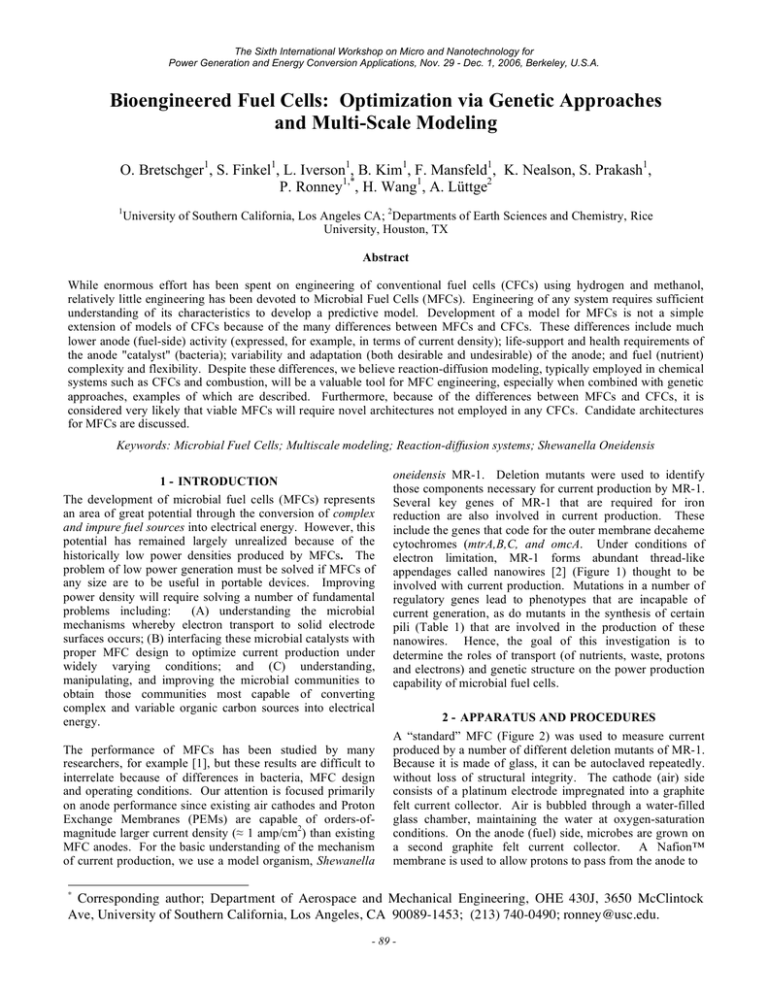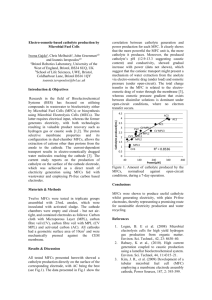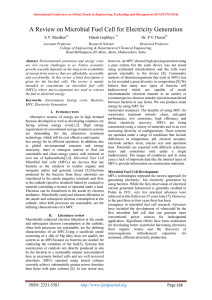Bioengineered Fuel Cells: Optimization via Genetic Approaches and Multi-Scale Modeling
advertisement

The Sixth International Workshop on Micro and Nanotechnology for Power Generation and Energy Conversion Applications, Nov. 29 - Dec. 1, 2006, Berkeley, U.S.A. Bioengineered Fuel Cells: Optimization via Genetic Approaches and Multi-Scale Modeling O. Bretschger1, S. Finkel1, L. Iverson1, B. Kim1, F. Mansfeld1, K. Nealson, S. Prakash1, P. Ronney1,*, H. Wang1, A. Lüttge2 1 University of Southern California, Los Angeles CA; 2Departments of Earth Sciences and Chemistry, Rice University, Houston, TX Abstract While enormous effort has been spent on engineering of conventional fuel cells (CFCs) using hydrogen and methanol, relatively little engineering has been devoted to Microbial Fuel Cells (MFCs). Engineering of any system requires sufficient understanding of its characteristics to develop a predictive model. Development of a model for MFCs is not a simple extension of models of CFCs because of the many differences between MFCs and CFCs. These differences include much lower anode (fuel-side) activity (expressed, for example, in terms of current density); life-support and health requirements of the anode "catalyst" (bacteria); variability and adaptation (both desirable and undesirable) of the anode; and fuel (nutrient) complexity and flexibility. Despite these differences, we believe reaction-diffusion modeling, typically employed in chemical systems such as CFCs and combustion, will be a valuable tool for MFC engineering, especially when combined with genetic approaches, examples of which are described. Furthermore, because of the differences between MFCs and CFCs, it is considered very likely that viable MFCs will require novel architectures not employed in any CFCs. Candidate architectures for MFCs are discussed. Keywords: Microbial Fuel Cells; Multiscale modeling; Reaction-diffusion systems; Shewanella Oneidensis 1 - INTRODUCTION The development of microbial fuel cells (MFCs) represents an area of great potential through the conversion of complex and impure fuel sources into electrical energy. However, this potential has remained largely unrealized because of the historically low power densities produced by MFCs. The problem of low power generation must be solved if MFCs of any size are to be useful in portable devices. Improving power density will require solving a number of fundamental problems including: (A) understanding the microbial mechanisms whereby electron transport to solid electrode surfaces occurs; (B) interfacing these microbial catalysts with proper MFC design to optimize current production under widely varying conditions; and (C) understanding, manipulating, and improving the microbial communities to obtain those communities most capable of converting complex and variable organic carbon sources into electrical energy. The performance of MFCs has been studied by many researchers, for example [1], but these results are difficult to interrelate because of differences in bacteria, MFC design and operating conditions. Our attention is focused primarily on anode performance since existing air cathodes and Proton Exchange Membranes (PEMs) are capable of orders-ofmagnitude larger current density (≈ 1 amp/cm2) than existing MFC anodes. For the basic understanding of the mechanism of current production, we use a model organism, Shewanella oneidensis MR-1. Deletion mutants were used to identify those components necessary for current production by MR-1. Several key genes of MR-1 that are required for iron reduction are also involved in current production. These include the genes that code for the outer membrane decaheme cytochromes (mtrA,B,C, and omcA. Under conditions of electron limitation, MR-1 forms abundant thread-like appendages called nanowires [2] (Figure 1) thought to be involved with current production. Mutations in a number of regulatory genes lead to phenotypes that are incapable of current generation, as do mutants in the synthesis of certain pili (Table 1) that are involved in the production of these nanowires. Hence, the goal of this investigation is to determine the roles of transport (of nutrients, waste, protons and electrons) and genetic structure on the power production capability of microbial fuel cells. 2 - APPARATUS AND PROCEDURES A “standard” MFC (Figure 2) was used to measure current produced by a number of different deletion mutants of MR-1. Because it is made of glass, it can be autoclaved repeatedly. without loss of structural integrity. The cathode (air) side consists of a platinum electrode impregnated into a graphite felt current collector. Air is bubbled through a water-filled glass chamber, maintaining the water at oxygen-saturation conditions. On the anode (fuel) side, microbes are grown on a second graphite felt current collector. A Nafion™ membrane is used to allow protons to pass from the anode to * Corresponding author; Department of Aerospace and Mechanical Engineering, OHE 430J, 3650 McClintock Ave, University of Southern California, Los Angeles, CA 90089-1453; (213) 740-0490; ronney@usc.edu. - 89 - The Sixth International Workshop on Micro and Nanotechnology for Power Generation and Energy Conversion Applications, Nov. 29 - Dec. 1, 2006, Berkeley, U.S.A. . Figure 1. Low-resolution (top) and high-resolution (bottom) images of MR-1 cells forming a biofilm with MFC1 “nanowire” appendages [2]. MR-1 Wildtype Figure 2. Microbial Fuel Cell used to gather data shown in Table 1. Top: schematic diagram; bottom: photograph. 0.3 3 - RESULTS A typical example of the current density obtained from Shewanella Oneidensis MR-1 are shown in Fig. 3. It can be seen that each time 0.002 moles of nutrient (lactate) was added to the cell, the current production increased dramatically. The time constant for consumption of this nutrient is about 15 hours, with a total current production of about 8 coulombs or 0.00022 moles of electrons, thus the ratio of nutrient (lactate) molecules to electrons produced is roughly 10:1. 0.25 Current (mA) 0.2 0.15 0.1 0.05 0 0 10 20 30 40 Time (hrs) 50 60 70 80 Figure 3 - Example of current production from Shewanella Oneidensis MR-1 microbial fuel cell. The three sharp increases in current correspond to the introduction of 2 mM lactate into the anode side of the MFC. cathode. A Keithley source meter was used to determine current production. Lactate was used as the nutrient in the tests described here. Preliminary results of the effect of deletion of specific sequences in the genome are shown in Table 1. These mutants targeted either regulatory genes or specific cytochromes. Interestingly, at least one cytochrome mutant was enhanced for current production suggesting that it might be involved with a competing pathway of electron flow within the cell. Optimization of current production will require an understanding of the physiology and energy flow within the bacteria. A major effort will be made to understand the - 90 - The Sixth International Workshop on Micro and Nanotechnology for Power Generation and Energy Conversion Applications, Nov. 29 - Dec. 1, 2006, Berkeley, U.S.A. factors involved in the regulation of energy flow and the partitioning of energy between growth and maintenance. As improvements are made in the electron transfer ability of MR-1, these will be analyzed in terms of MFC power production and system efficiency. For example, our work has shown that various strains of Shewanella can oxidize (i.e., eat) a wide variety of organic carbon compounds. For example, MR-1 can use at least 18 different compounds and others strains can use more than 40. However, we have found that many of these compounds that can be oxidized will not support growth. These may be precisely the compounds we would like to use in MFCs – is it possible to feed the bacteria one compound to grow a biofilm on the anode, then feed this biofilm different compounds to produce a non-growing, current-producing system? Alternatively, some Shewanella strains produce copious amounts of formate when grown on more complex carbohydrates. This suggests that a double-electrode fuel cell might be possible, harvesting electrons directly from the bacteria and harvesting further electrons via a formate fuel cell. Mutant Designation MR-1 E. coli mtrA mtrB mtrC mtrD mtrE mtrF omcA gspD tatC crp The phenomenological part of the model will characterize anode performance on the basis of fuel cell responses (e.g., current density, products of metabolic activity) to test parameters. Based on the dependence of power density as a function of microbial cell density N and active electron transfer sites per cell A postulated in Figure 3, the kinetic rate expression for the power density Re may be written as ! [ "# + ( Re,$ ) "# # ] density, where Re is expected to be proportional to the cell density and probably the active electron transfer sites per cell A, i.e., Re,0 (A) = aAN (2) Re,∞ corresponds to the limit of large cell density, where the microbial cells undergo excessive competition for nutrients and electron transfer sites on the anode. Therefore an increase the cell density can cause Re,∞ to decrease, i.e., Re," (A) = b /N (1) Here Re,0(A) is the power density at the limit of low cell ! Figure 4 – Schematic of dependence of power density on microbial cell density and electron transfer sites per cell. % Max. Current 100 % nd nd nd ≈ 30 % 100 % ≈ 160 % ≈ 80 % nd ≈ 10 % ≈ 15 % ≈ 20 % Wild Type Wild Type Fe reduction structural gene Fe reduction structural gene Fe reduction structural gene Unknown structural gene Unknown structural gene Unknown structural gene Fe reduction structural gene Type II secretion system Membrane protein insertion Regulatory gene (C-metabolism) Fur Regulatory gene ≈ 25 % (Fe metabolism) luxS Regulatory gene 100 % (quorum sensing) Table 1 - Results of MFC testing of some mutants of MR-1. The normal strain (wild type) produces ≈ 70 µA of current (with 18 cm2 anode area), while a negative control (E. coli) produces a baseline current of about 5 µA. Note that several mutants (mtrABC, omcA) produced no measurable current (nd), while others were impaired with regard to current production, and one, mtrE produced more current than the wild type. A number of regulatory mutants (tatC, fur, crp) are depressed with regard to current production. 4 - DISCUSSION A robust multi-scale, multi-phenomenon computer model of an MFC system is being developed that subsequently can be used for testing, predicting and optimizing fuel cell design (e.g., miniaturization) and efficiency. The primary focus is on the anode because of its low current density. Initially, the PEM and cathode processes are not expected to be ratelimiting. Re = ( Re,0 ) Mutant Class ! (3) The kinetic expression (1) intends to capture the transition region, from the low-to-high cell density limits, where cooperation within the microbial cell community is amplified. Beyond the phenomenological model, a physical model will be developed and critically validated within the active parameter space. The low currents obtained from MFCs may suggest a paradigm shift in terms of the optimal operating conditions. For example, we note that the O2 permeability of Nafion-117 at 25˚C is about 10-14 Mole/m-s-Pa [3]. Assuming an air cathode (PO2 = 21,000 Pa) with a 100 µm membrane, this O 2 leakage results in a 0.82 A/m2 current loss – trivial for hydrogen , methanol or formic acid fuel cells whose current density may approach 10,000 A/m2, but substantial for MFCs whose current density (in our baseline case) is (70 µA)/(18 cm2) (10-4 m2/cm2) ≈ 0.04 A/m2. In contrast, for high-current fuel cells using conventional fuels, the main loss mechanism is not oxygen diffusion, but rather resistive losses - 91 - The Sixth International Workshop on Micro and Nanotechnology for Power Generation and Energy Conversion Applications, Nov. 29 - Dec. 1, 2006, Berkeley, U.S.A. in the membrane. For example, the proton conductance of Nafion-117 at 25˚C is about 0.08 S/cm [4], which results in a 12 µV drop for 1 A/m2 - trivial for MFCs with a typical open circuit voltage of ≈ 0.3 volts, but results in a 0.12 V drop for a current density of 1 A/cm2 - a dominant factor for conventional fuel cells. Since resistive losses in Nafion is not an issue for MFCs, but O2 crossover is, one could use different material with lower O2 permeability at the expense of lower proton conductivity, or an entirely different type of fuel cell structure, an example of which is shown in Fig. 5. In this design, “fins” are employed using laminated Nafion. The optimal ratio of fin width to length can be calculated for a give current density, oxygen permeability and proton resistance. Note also that in the design shown in Fig. 5, the inner PEM layers should be thicker than the outer layers since the protons must be conducted farther in the case of the inner layers. Also, as a result of this structure, the anode area will be much greater than cathode area, which is appropriate since the anode surface reaction rate is much smaller than that on the cathode. With this scheme, it is potentially possible to practically eliminate O2 crossover without incurring significant voltage loss due to proton resistance. conventional and microbial fuel cells is required, for example relative importance of oxygen crossover vs. proton resistance and the opportunities to increase current production via genetic approaches. ACKNOWLEDGEMENTS This work was supported by the AFOSR MURI program, Award No. FA9550-06-1-0292. REFERENCES [1] Jang, J. K., T. H. Pham, I. S. Chang, T. H. Kang, H. S. Moon, K. S. Cho, and B. H. Kim. Construction and operation of a novel mediator- and membrane-less microbial fuel cell. Process Biochem. 39:1007-1012, 2004. [2] Gorby, Y., et al., Electrically conductive bacterial nanowires produced by Shewanella oneidensis strain MR-1 and other microorganisms. Proc. Nat. Acad. Sci. U.S.A., 103:11358 – 11363 (2005). [3] Kocha, S. S. Yang, J. D., Yi, J. S., Characterization of Gas Crossover and Its Implications in PEM Fuel Cells. AIChE J. 52, 1916 – 1925 (2006). [4] Siu, A., Schmeisser, J., Holdcroft, S., Effect of Water on the Low Temperature Conductivity of Polymer Electrolytes. J. Phys. Chem. B. 6072 – 6080 (2006). Figure 5 – Possible configuration of microbial fuel cells for optimization of power generation by minimizing oxygen crossover without significantly increasing resistive losses (only applicable for low-current devices such as MFCs). 5 - CONCLUSIONS Experiments using Shewanella Oneidensis MR-1 in a microbial fuel cell with a conventional Nafion membrane demonstrate the possibility of generated electrical power from common nutrient feedstocks. However, to exploit this opportunity, consideration of the differences between - 92 -




